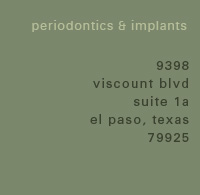- general information
- patient information
- Periodontal Overview
- ––––––––––––––––––––––––––––––––––
- Periodontal Disease and Heart Disease
- Diabetes and Periodontal Diseases
- Periodontal Disease Risk Factors
- Periodontal Complications
- Oral Cancer
- • Biopsy
- Maintaining Periodontal Health throughout a Woman's Lifetime
- Other Diseases and Their Relationship to Periodontal Disease
- Heart Disease: Precautions to be Taken Before Dental Treatment
- Poor Nutrition and Periodontal Disease
- ––––––––––––––––––––––––––––––––––
- What is "Good Oral Hygiene"?
- How to Brush
- How to Floss
- How to Care for Sensitive Teeth
- Hygiene Products
- • Toothbrush Care
- ––––––––––––––––––––––––––––––––––
- New Patient FAQs
- First Visits FAQs
- non-surgical periodontal care
- periodontal therapies
- Traditional Pocket Reduction Therapy
- • Bone Grafting
- ––––––––––––––––––––––––––––––––––
- PerioLase™ LANAP Therapy
- ––––––––––––––––––––––––––––––––––
- Cosmetic Surgery to Improve the Appearance of Your Smile
- • Crown Lengthening to Improve the Esthetics of Your Smile
- • Soft Tissue Grafting to Address Gingival Recession (Root Coverage Grafting)
- Platelet Rich Plasma (PRP)
- Crown Lengthening to Repair a Damaged Tooth
- Exposure / Bracketing of Impacted Tooth
- • Procedure Description for Exposure/Bracketing of Impacted Tooth
- ––––––––––––––––––––––––––––––––––
- Pocket Reduction Surgery FAQs
- Other Therapies FAQs
- dental implants
- Introduction to Dental Implants
- • Single Missing Tooth
- • Two or More Missing Teeth
- • Current Denture User
- • Benefits of Dental Implants
- ––––––––––––––––––––––––––––––––––
- CT Scanner & Comprehensive Implant Planning
- Conscious I.V. Sedation: Is It Right for You?
- ––––––––––––––––––––––––––––––––––
- Socket Preservation Techniques
- Ridge Augmentation and Bone Grafting
- Sinus Graft
- Platelet Rich Plasma
- Routine Implant Maintenance
- our doctors & staff
- office information






Home
Periodontal Therapies
- Traditional Pocket Reduction Therapy
- • Bone Grafting
- PerioLase™ LANAP Therapy
- Cosmetic Surgery to Improve the Appearance of Your Smile
- • Crown Lengthening to Improve the Esthetics of Your Smile
- • Soft Tissue Grafting to Address Gingival Recession (Root Coverage Grafting)
- Platelet Rich Plasma (PRP)
- Crown Lengthening to Repair a Damaged Tooth
- Exposure / Bracketing of Impacted Tooth
- • Procedure Description for Exposure/Bracketing of Impacted Tooth
- Pocket Reduction Surgery FAQs
- Other Therapies FAQs
PerioLase™ Laser lanap Therapy
What Is Gum Disease?
Gum disease begins when a film called plaque accumulates on the teeth. Certain strains of bacteria that live in this plaque damage gum tissue and bone. Your body tries to fight this infection with an inflammatory assault, sending white blood cells to the area to destroy the bacteria. This inflammation causes the tissue to bleed easily when you brush or floss. This stage of the condition is called gingivitis.
If the infection and inflammation persist, what results is a chronic inflammatory condition in which the gums and bone around the teeth are slowly destroyed, many times with no awareness or symptoms. At this stage, it is called periodontitis.
The biggest risk factors are ineffective home care and smoking. Periodontitis has been linked to an increased risk for heart disease, diabetes, and other serious medical conditions. In short, healthy gums are the gateway to a healthier body.
Options and Alternatives
Once your condition has progressed to periodontitis, surgical intervention is usually necessary to eliminate the deep pockets which develop between the teeth and gums. If these pockets persist, they become “privileged sites” for bacteria to organize even more colonies.
Traditional gum surgery involves cutting away some of the gum tissue, and reshaping the bone underneath. LANAP is a progressive technique using a specialized laser to destroy the bacteria which cause disease, and alter the tissue so that it has the opportunity to heal. The use of the laser is less invasive than traditional scalpel surgery, and results in a much faster and less painful recovery.
How LANAP Works
- Depth of pocket is measured under anesthesia
- Laser selectively removes pocket lining
- Ultrasonic instruments clean root surfaces
- Laser disinfects pocket and seals the wound
- Tissue is compressed against the tooth
- Bite is adjusted through selective grinding
- Healing results in new attachment
Your Surgical Visits
Usually, we treat one half of the mouth at a time. The surgical visits are ideally made one to two weeks apart, and take about two hours each on average.
The mouth is numbed, just like if you were having a filling or crown done. Sedation is available if you prefer. The pockets are then measured while you are numb, so that more accurate measurements can be made without causing discomfort.
A first pass is made with the laser, giving the doctor access to the depth of the pockets and allowing better visualization of the roots of the teeth. Then the teeth are cleaned very thoroughly using ultrasonic instruments, which have tips that vibrate very quickly, loosening up any deposits on the teeth and flushing them away with an irrigating solution.
A second pass is made with the laser, disinfecting the pockets and sealing them up through the formation of a stable blood clot. The bite is then adjusted to minimize destructive, uneven clenching forces on the teeth.
The First Few Days
Most people experience some mild soreness of the treated areas for the first few days. The tissue will appear discolored around the teeth, similar to what a scab looks like when you get it wet. It is very important NOT to brush or pick this away, as this fibrin barrier is what allows the gums underneath to get a head start creating a new attachment to the teeth.
Your bite will feel different, as if the teeth don’t touch together as heavily on the treated side. This can feel imbalanced at first, but the teeth will quickly adapt. After both sides have been treated, as further refinements are made, your bite should feel stronger and more stable than ever, and more comfortable.
Continuing Follow-Up Care
As the gums heal, the teeth will shift, and your bite will need to be adjusted several times over the first few weeks, even for the first year and beyond. Although it seems counter-intuitive, inadequate adjustment is what is usually responsible for soreness or sensitivity following LANAP.
Three to six weeks after your surgery, impressions will be made of your teeth, and splints will be fabricated to stabilize and immobilize the teeth while you sleep. It is important to wear these splints, as we humans have a tendency to periodically clench our teeth and jaws during sleep. This clenching can produce extremely damaging forces which can delay or prevent healing.
Professional cleaning is recommended every three months for the first year, and re-evaluation of your condition will be done at the twelve month visit. Most people with gum disease remain at risk for the rest of their lives, and would benefit from having their teeth cleaned every three months indefinitely.
9398 Viscount Blvd, Suite 1-A | El Paso, TX 79925 | Tel 915-598-6702 | Fax 915-593-7478
Home | General Information | Patient Information | Non-Surgical Periodontal Care | Periodontal Therapies | Dental Implants | Our Doctors & Staff
Contact Us | Referring Doctors | Disclaimer | Sitemap | Periodontic Website Designby PBHS 2012©